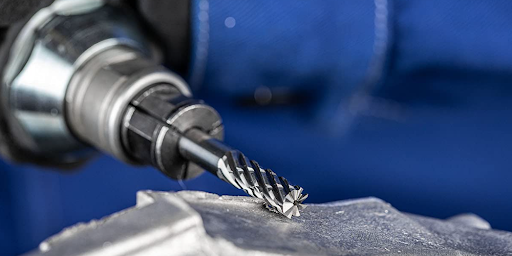Need versatile tool bits that can grind, shape, smooth, cut, and get rid of excess materials? Carbide burr is the ideal choice for a range of applications, from welding, general repairs, machining metal parts, making jewelry, or dental procedures. The bits are made of extremely hard metals, and when combined with high RPMs in the appropriate rotary tool get precise results within a matter of minutes. The hardest part may be choosing the right rotary burr cutter for the job at hand.
What Exactly Are Carbide Burrs?
To remove any confusion, these tool bits go by different names—die grinder bits, burr cutters, and carbide burrs—are just a few, but essentially all are made of tungsten carbide and used with a range of rotary tools at varying speeds. Various in shape and size, these tools yield diverse outcomes across different materials. Among the toughest alloys known, tungsten carbide ranks next to natural and synthetic diamonds and possesses the ability to penetrate almost any substance.
Their cutting capabilities extend to ferrous and non-ferrous metals like stainless steel, steel alloys, aluminum, copper, zinc, and nickel, along with precious metals like gold, silver, and platinum, commonly used in jewelry crafting. Additionally, they’re adept at handling metals such as bronze and brass, frequently employed in decorative items. Beyond metal, these tool bits effortlessly handle plastics, ceramics, stone, bone, and tiles, as well as hard and softwoods.
Due to their versatility across such a wide spectrum of materials, burrs find ubiquitous use in numerous industries including carpentry, woodworking, machining, automotive repairs, welding, plumbing, construction, sculpting, artistic endeavors, dentistry, and many other professional fields.
What Can They Do?
So what exactly can burrs do? They’re ideal for milling purposes and creating holes in the desired width and depth, for heavy stock removal, such as rust, getting rid of excess materials like splatter in welds, bringing materials and products to a clean, smooth finish, for instance, removing machining marks or adding details to woodwork. And they get ideal results in forgings, dies, and molds. Of course, outcomes depend largely on the cutting burr profile and shape, the speeds at which they spin when attached to the right tool, and the materials they’re used on.
Carbide burrs are exceptionally durable, particularly when compared to ordinary HSS bits, undergo considerably less metal fatigue, and don’t get as hot. This means they can be used at much higher RPMs, in turn significantly speeding up work without the fear of damage to workpieces.
Choosing the Right Cutting Profiles
When shopping for burr cutters, have in mind the differences in cutting profiles. Aluminum or single-cut burrs have a single right-cutting profile or flute from top to bottom. This works better in stock material removal and at faster speeds, in general, for deburring purposes and milling.
Use singe-cut burrs for smoothing out rougher surfaces, such as weld spatter and rust. The name implies that these are preferred in aluminum pieces, as well as magnesium and zinc alloys, or harder plastics and rubber. They can also be used on steel, iron, and other ferrous or harder metals, but won’t bring the fine, smooth finish offered by double-cut variants.
These tools possess intricate left and right cutting profiles, resulting in finer and intersecting patterns. Their design excels in achieving smoother finishes, making them highly suitable for various metal types. They are particularly favored in dentistry and jewelry making for tasks such as polishing, carving, and engraving.
The double-cut (or diamond) burrs offer enhanced precision and are notably gentle on softer materials. Surprisingly, they maintain their effectiveness even on high-density metals like titanium, chromium, and iridium, showcasing their versatility across a wide array of materials.
Lastly, choose standard-fluted burrs for general-purpose work across a range of different materials. These are good for deburring and stock removal, particularly in metals, where they produce long chips.
Shapes and Sizing Burrs According to Usage
Burr shapes are another thing to consider. Shapes determine the cut you get in the workpiece. Ball burrs are used to get concave cuts or when hollowing out wood, metals, and other materials. Tree burrs, either with a rounded or pointed tip, are good for rounding off edges and to get acute angles. Inverted cone types are ideal for chamfering and making V-cuts, while standard cylindrical burr cutters are used for right-angle cuts, as well as general smoothing and countersinking. And if you need rounded edges, go with oval or flame burrs.
While these are the main burr shapes, there are dozens of specialized shapes to suit different purposes. A good idea is to get packaged sets in different shapes to allow for different cuts and extend the versatility of the tool bit for different tasks.
Sizing die grinder burrs is also important. Sizes refer to the diameter of the burr head and range from a minute 1.6mm to 16mm. Smaller burrs can understandably be used at higher RPMs, roughly 35000, and the top speeds you see in dremels and engravers in jewelry and rotary tools in dentistry. Medium variants (3 to 6mm) used with die grinders round out at 15 to 20000 RPMs, while the biggest burrs are safely used at around 10 to 12000 RPMs.
Of course, you can vary the speed at which the cutting burr and tool spin depending on the hardness of the materials. For harder metals like steel, you’ll be looking at short bursts of 35 thousand RPM with 6mm burrs, or around 20 thousand rotations a minute in 16mm variants. Softer metals can be worked at much slower speeds, and the same applies to plastics and wood. One last thing to remember in terms of sizing is that these tool bits can also be optioned with standard or lengthened shanks, and the latter is good for hard-to-reach areas.
Tips on Using Burr Cutters
Burrs clamp onto rotary tools via collets or chucks. Once secure, begin with lower speeds and apply little pressure to the workpiece. This ensures the cutting edges stay intact and prolongs burr life. Use short up and down strokes to let the burrs cool and get rid of chips stuck in the flutes, and to avoid leaving marks or roughness in the workpiece. Finish work on the upstroke. Since chips present a safety risk, use the proper PPE gear, especially eye protection at all times.




